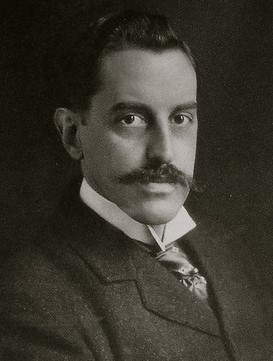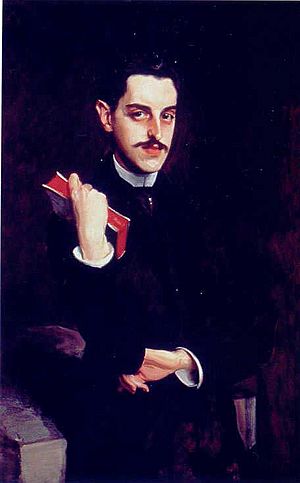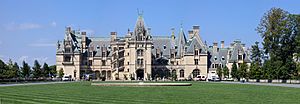George Washington Vanderbilt II facts for kids
Quick facts for kids
George Washington Vanderbilt II
|
|
|---|---|
 |
|
| Born | November 14, 1862 New Dorp, Staten Island, New York, U.S.
|
| Died | March 6, 1914 (aged 51) Washington, D.C., U.S.
|
| Resting place | Vanderbilt Family Mausoleum, Staten Island, New York, U.S. |
| Known for | Biltmore Estate |
| Spouse(s) |
Edith Stuyvesant Dresser
(m. 1898) |
| Children | Cornelia Stuyvesant Vanderbilt |
| Parent(s) | William Henry Vanderbilt Maria Louisa Kissam |
| Relatives | Vanderbilt family |
George Washington Vanderbilt II (born November 14, 1862 – died March 6, 1914) was a famous art collector. He was part of the wealthy Vanderbilt family. This family made a huge fortune from steamboats, railroads, and other business enterprises. George Vanderbilt is best known for building the Biltmore Estate. It is a massive 250-room mansion and the largest privately owned home in the United States.
Contents
About George Vanderbilt
George W. Vanderbilt was the youngest child of William Henry Vanderbilt and Maria Louisa Kissam. He was his father's favorite child and often spent time with him. People described George as shy and quiet. He loved philosophy, books, and collecting paintings. He had a huge private library with over twenty thousand books!
George traveled a lot, especially to Paris, France. He became fluent in several foreign languages. His family owned beautiful homes in New York City and Newport. They also had a large country estate on Long Island.
When his father died in 1885, George inherited a lot of money. This allowed him to focus on his intellectual interests. He lived with his mother in Manhattan for a while. Later, he moved into his own townhouse. His older brothers managed the family businesses. In 1892, George Vanderbilt gave his private art gallery in Manhattan to the American Fine Arts Society.
Building the Biltmore Estate
In 1888, George Vanderbilt decided to build his own country home. He bought 125,000 acres of forest land in North Carolina. He hired a famous architect named Richard Morris Hunt. The house was designed to look like French castles from the Loire Valley. The Biltmore Estate is huge, with about four acres of floor space. It is believed to be the largest home ever built in the United States by a private owner.
At Biltmore, George Vanderbilt lived like a country gentleman. He was very interested in horticulture (gardening) and farming. He ran experiments in scientific farming and animal breeding. He also studied silviculture (forestry). His goal was to make Biltmore a self-sustaining estate. This meant it could produce everything it needed.
In 1892, Frederick Law Olmsted suggested that Vanderbilt hire Gifford Pinchot. Pinchot was a forestry expert. He later became the first Chief of the United States Forest Service. According to Pinchot, Biltmore was the first professionally managed forest in the U.S. It was also home to the Biltmore School of Forestry. This was the first school of its kind in North America. It was started in 1898 by Dr. Carl A. Schenck.
Vanderbilt was known for being very kind to his employees at Biltmore. Every year, he held a Christmas party for their children. There was a decorated tree and presents for every child. He also paid all the costs for the Cathedral of All Souls. This church was across from the Biltmore Estate's main gate. He built it for the people who worked on his estate. This way, the church's weekly collection could go directly to help people in need.
George Vanderbilt's Family
On June 1, 1898, George Vanderbilt married Edith Stuyvesant Dresser. They were married in Paris, France. George and Edith had one daughter together, Cornelia Stuyvesant Vanderbilt.
In 1912, George and Edith planned to travel on the famous ship, the Titanic. However, they changed their plans at the last minute. They decided to sail on the Olympic instead. The Olympic left port before the Titanic. This meant the Vanderbilts arrived safely in New York before the Titanic sank. Some stories say a family member warned them not to travel on a ship's first trip. Other stories say George's mother had a bad feeling about the Titanic. Whatever the reason, they switched ships. Sadly, one of their servants, Frederick Wheeler, died aboard the Titanic. He was traveling with most of their luggage because of the last-minute change.
Death and Legacy
George Vanderbilt died on March 6, 1914, in Washington, D.C.. He passed away due to problems after an appendectomy (surgery to remove the appendix). He was buried in the Vanderbilt family mausoleum in Staten Island, New York.
After his death, George's wife, Edith, sold a large part of the Biltmore property. She sold about 86,000 acres to the United States Forest Service. She sold it for $5 an acre. This helped create the main part of Pisgah National Forest. This sale fulfilled George's wish to protect the land. She sold more land as needed. Today, about 8,000 acres of the original estate remain. Edith Dresser Vanderbilt later married Peter Goelet Gerry, who was a United States Senator.
George and Edith's only child, Cornelia Stuyvesant Vanderbilt, married a British aristocrat in 1924. Their sons, George and William, later inherited the Biltmore property. George Cecil inherited most of the land and the Biltmore Farms Company. William Cecil inherited Biltmore House itself. William is given credit for saving the mansion. Today, Biltmore House is still privately owned but is open to the public to visit.



